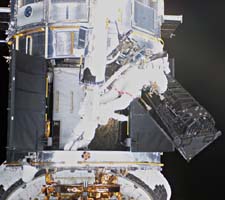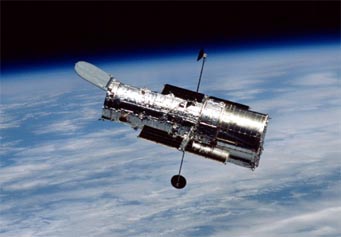
During the last Hubble servicing mission in March 2002, James Newman (foreground) and Michael Massimino replaced the Faint Object Camera with the much more powerful Advanced Camera for Surveys. Two more Hubble instruments have been built — the Cosmic Origins Spectrograph and the Wide Field Camera 3 — but with the cancelation of the next servicing mission in 2006, they'll likely never fly.
Courtesy NASA.
On Friday, January 16th, NASA administrator Sean O'Keefe announced that there will be no more shuttle missions to service the Hubble Space Telescope. The agency will operate the orbiting observatory only until it succumbs to a critical system failure, which could happen as soon as today or as late as several years from now. Either way, Hubble's clock is running down.
News of O'Keefe's decision spread like wildfire on Friday afternoon, as somber e-mail messages from Space Telescope Science Institute (STScI) director Steven Beckwith and American Astronomical Society president Caty Pilachowski (Indiana University) made the rounds among astronomers worldwide. Coming only two days after President George W. Bush's announcement of a new national space policy aimed at sending humans back to the Moon and then on to Mars, O'Keefe's decision to abandon Hubble was widely interpreted as the first of many sacrifices science would have to make to help pay for the president's new initiatives.
Such a reaction, while understandable given the checkered history of the US space program, may be misguided. "I would urge all astronomers not to jump off any buildings yet," says space-science chief Edward Weiler (NASA Headquarters). "Wait till the president's budget comes out on February 3rd," he advises, "then decide if you really want to jump." Weiler insists that space-science funding will remain robust, and that in particular NASA is committed to building the James Webb Space Telescope, considered Hubble's successor and currently scheduled for launch in 2011. Robotic exploration of the solar system and advanced telescopic searches for planets around nearby stars, two programs especially favored by astronomers, are explicitly included in the president's plan.
"We had money to do the next Hubble servicing mission," Weiler adds, "but we could only do it if it was deemed safe." And there's the rub. One of the key recommendations of the Columbia Accident Investigation Board is to develop the capability to inspect the shuttle for damage once in orbit and to make repairs before the craft returns to Earth. This will be hard enough to do for missions to the International Space Station (ISS), which offers plenty of room for tools and equipment as well as a haven for the crew of a stricken shuttle. But it would be even harder to do for a visit to Hubble, which flies in an orbit from which the ISS is inaccessible.
If the shuttle were going to be used for a variety of missions besides finishing ISS construction, NASA would undertake the effort to develop a standalone inspection-and-repair capability. But now that President Bush has decreed that the shuttle will be phased out by 2010, Hubble remains the lone non-ISS destination for it. By canceling further Hubble servicings, NASA administrator O'Keefe avoids having to develop an expensive technology that will be used at most on a single shuttle flight.
Not all astronomers are prepared to accept this reasoning. "What we are seeing is a big loss of nerve on the part of NASA," says former Hubble project scientist C. Robert O'Dell (Vanderbilt University). "Previous risks in shuttle operations are no longer acceptable. The agency is now headed by someone from outside the space-exploration community," O'Dell continues, referring to O'Keefe's earlier position in the Office of Management and Budget, "and a major accident has occurred on his watch, making it difficult to 'stay the course' in a time of adversity."

Astronauts of the shuttle Columbia released the Hubble Space Telescope back into free flight at the end of the last servicing mission on March 9, 2002. During the five-day visit they carried out a series of repairs and upgrades.
Courtesy NASA.
So what happens now? According to NASA chief scientist John Grunsfeld, an astronomer-astronaut who has twice serviced Hubble, mission controllers will do everything they can to extend the observatory's lifetime. The two systems most likely to render Hubble useless are its gyroscopes, which keep the telescope pointed at celestial targets, and its batteries, which provide power when the spacecraft is in shadow. In normal operations Hubble needs three gyros; among its complement of six, two have already failed and a third is showing signs of trouble. Engineers are already working on a way to control the telescope with just two gyros, if only for limited observations.
"The real problem is the batteries," says Grunsfeld. "They're the originals from 1990, and we were going to replace them on the next servicing mission in 2006." Like ordinary household rechargeable batteries, Hubble's lose their potency after repeated cycles of charging and discharging. "We hope we can coax another three or four years out of them," says Grunsfeld. NASA's Weiler adds, "We've never had to conserve resources before; we always knew there was another servicing mission two or three years down the road. Perhaps by running one science instrument at a time, instead of all of them at once, we can conserve power and keep Hubble alive longer."
Originally, Hubble was to return to Earth aboard the shuttle at the end of its mission, but that's no longer an option. Worried about the danger to people and property on the ground should the massive, bus-size telescope burn up in the atmosphere, NASA now plans to develop a robot that will fly to the telescope, attach a retrorocket, and steer the spacecraft to a harmless reentry over an unpopulated area. The cost of such a device is likely to run into the hundreds of millions of dollars, comparable to that of a Hubble servicing mission, but since the same type of robot could be used to safely deorbit other large satellites in the future, it's a cost NASA is willing to bear.
STScI director Beckwith urges that astronomers not give up hope. Perhaps, he suggests, the same robot that delivers a retrorocket to Hubble could be used to install new gyros or batteries. "I think we should think positively about ways to use or even service Hubble without the shuttle and see if we cannot find something that would be attractive to NASA and preserve our observatory."
 0
0
Comments
You must be logged in to post a comment.